Difference between 2-Stroke and 4-Stroke Engines
Internal combustion Engines have changed our world in the past few centuries. Today we are able to travel so far and so fast only due to these small mechanical devices and how it works is beautiful!
Internal Combustion Engines can be divided into 2-strokes and 4-stroke.
The major difference between the 2-stroke and the 4-stroke engine is that the 2-stroke engine makes power for every one rotation of the crankshaft, whereas the 4-stroke engine makes power once for every 2 rotations of the crankshaft.
Other Differences:
2-Stroke
4-Stroke
| Torque | High at Low RPM | Low at Low RPM |
| Fuel Efficiency | Low | High |
| Oil | Mixed with Fuel | Separate from Fuel |
| Weight of Engine (to produce the same amount of Power) | Low | Higher in Comparison |
| Inlet/Outlet | Only ports. The piston itself acts like Valves. | Uses Valves and Camshaft to open and Close the Valves. |
| Cost | Expensive | Cheap in comparison |
Working
How engines work is truly beautiful. For any internal combustion engine, there are only 3 major events that take place, they are:
- Opening of the intake.
- Spark causing an explosion.
- Exhaust letting the burnt gas out.
Both the 2-stroke and 4-stroke engines take a different approach to how these 3 events will take place. But the goal is the same, i.e, burning the fuel-air mix to create power that we can use to power vehicles, generators, etc.
Terms To Know:
- Stroke: One Stroke is the movement of the piston from bottom to the top of the cylinder or from top to bottom.
- Inlet: The hole from which the gas-fuel mix comes inside the combustion chamber.
- Exhaust: The hole through which the burnt air goes out of the combustion chamber.
4- Stroke Engine’s Working
4-Stroke Engines are a lot more complex in comparison to 2-stroke but are simpler to understand, so we’ll start with this instead. Let’s have a look at their diagram and it’s working:
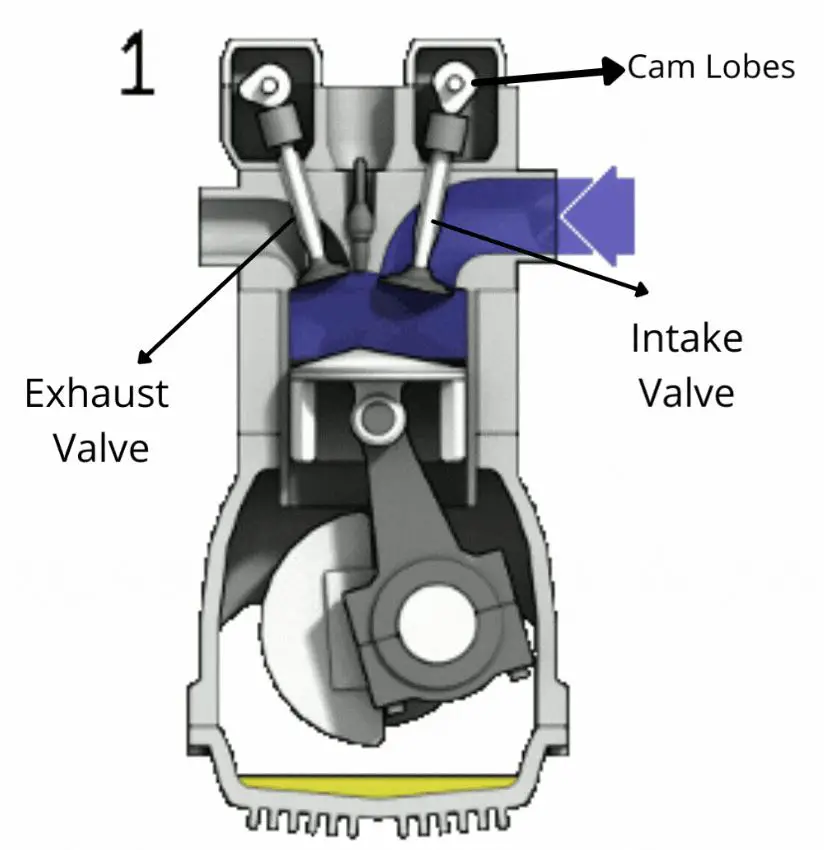
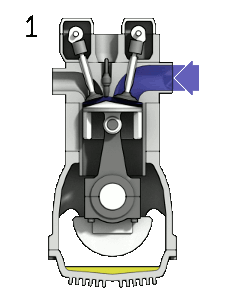
First Stroke (Intake)
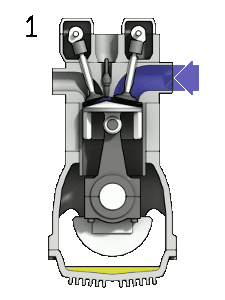
- The Inlet valve opens.
- Air-Fuel Mix comes in from the inlet port.
- The piston moves down.
Notice the cam lobe, it pushes the inlet valve downwards.
The camshaft maintains the timing of each event. Keep an eye on the cam lobes.
Second Stroke (Compression)
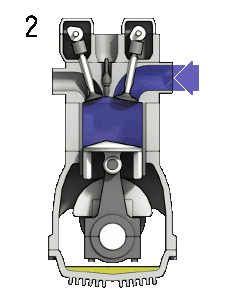
- Both Inlet and Exhaust Valves are closed.
- Piston Pushes up and compresses the air-fuel mixture that entered the Combustion camber in 1st Stroke.
Third Stroke (Combustion)
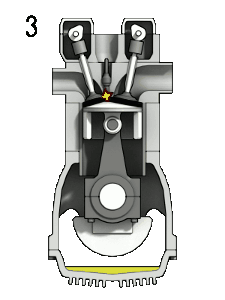
- Spark Plug Produces a Spark.
- The air-fuel mix burns which pushes down the piston.
Fourth Stroke (Exhaust)
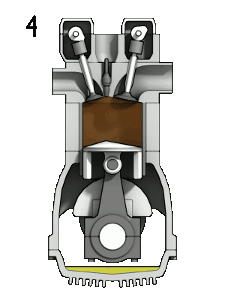
- Exhaust Valve is opened by the cam lobes.
- Piston moves back up.
- Burnt Gas moves out of the chamber.
The camshaft is a very important part of the 4 stroke engine. They are geared with the crankshaft to time the events perfectly. They might seem a little complex but aren’t really, since the crankshaft makes 1 rotation per 2 strokes it makes sense to use their rotation to time the valve opening.
If you want to learn more about camshafts then you can check its wiki page. But all you need to know is that it controls the timing at which the valves are opened.
Real World Operation
No machine is ideal. This is not exactly how a real-world engine works.
- The valves aren’t always closed in the 2nd and 3rd stroke and
- Combustion doesn’t take place right at the beginning of the 3rd stroke.
- Intake valves have to be opened for a longer duration, so they are opened sometime before the first stroke and closed some time after the first stroke.
- Similarly, the exhaust valves are opened sometime before the 4th stroke and closed a little after the 4th stroke.
- Combustion always takes place 20-40° before the 3rd stroke. A degree is just a way to measure timing, each stroke is 90°.
2-Stroke Engine’s Working
2-Stroke Engines are relatively simpler in how they work. There aren’t many working components in it. It only needs 2 strokes between combustion, i.e, the piston only has to travel 2 cycles for one power stroke. Here’s an animation of a 2 stroke engine and the parts diagram.
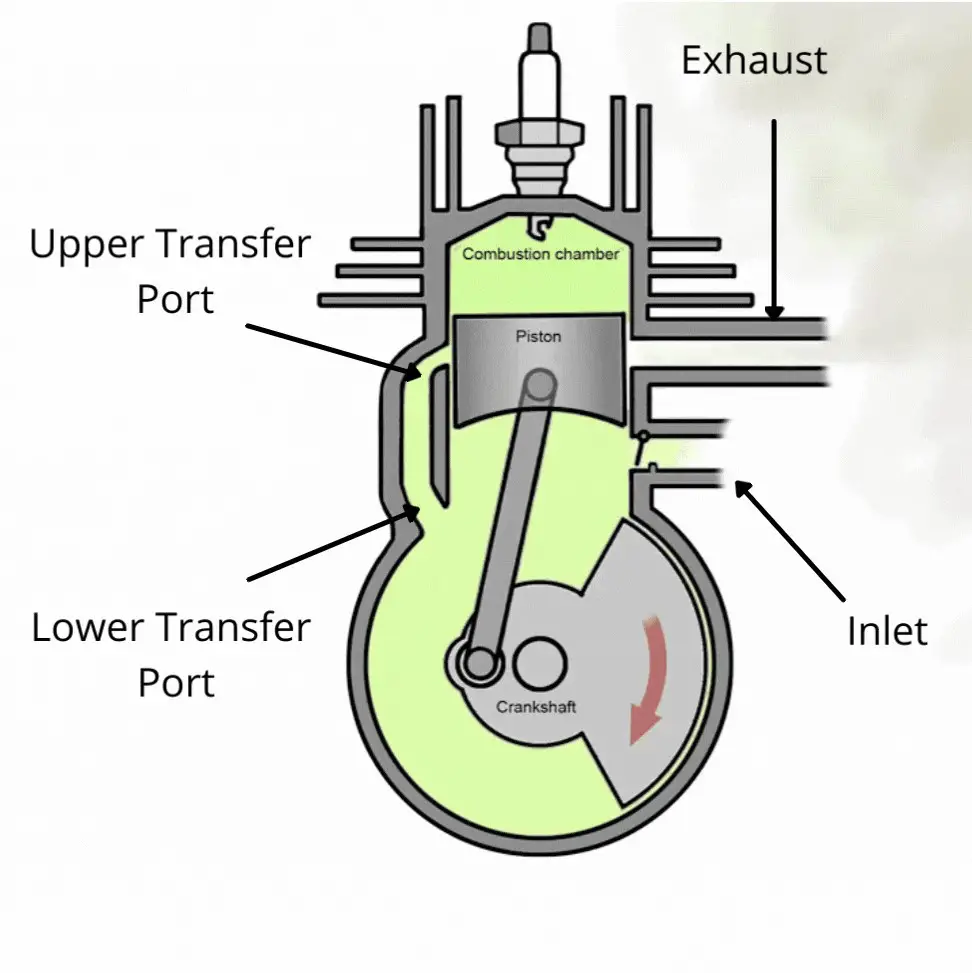
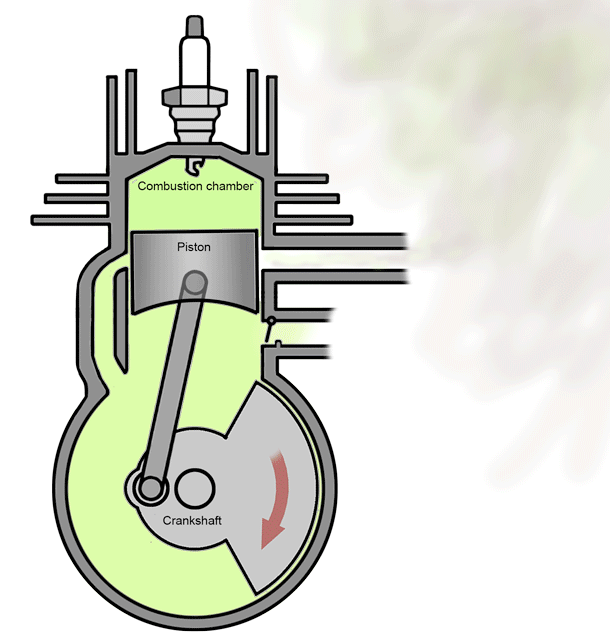
Let’s have a look at what’s happening in both the strokes
First Stroke (Compression & Intake)
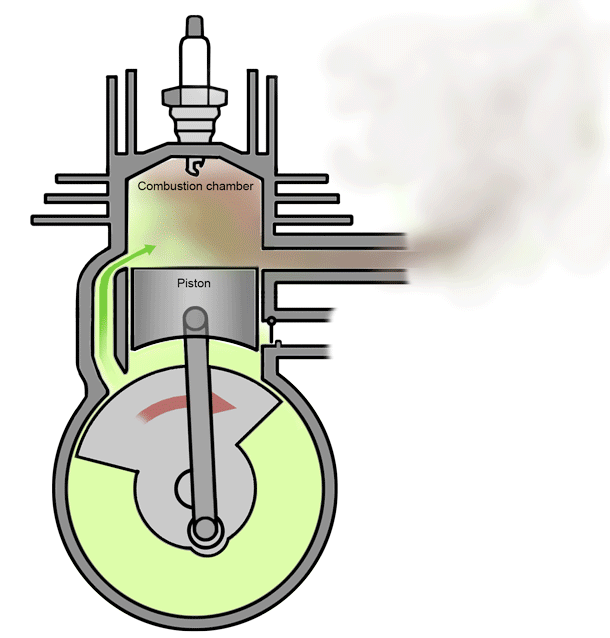
- The already burnt gas from previous cycle goes out.
- Gas from crankcase moves above the piston from the Upper transfer port.
- Piston pushes up to compress the new gas
Notice the Inlet port opens so that the new gas-fuel mix can enter the lower half of the chamber from the fuel injector/carburetor.
While the exhaust port is closed by the piston so that the gas cannot simply come in from the inlet to then go out from the exhaust, unburnt.
Second Stroke (Power & Exhaust)

- Spark Plug creates a spark which causes combustion.
- Piston gets pushed down due to combustion.
- Exhaust port opens due to piston moving down and the burnt gas is released
Note the inlet gets closed by the piston as it moves down.
The placement of the inlet, exhaust, and transfer ports is very crucial for these engines. The ports must open and close at the right time.
This animation shows an ideal engine, but as mentioned earlier, no machine is “ideal”. Some fuel that enters will go out of the exhaust unburnt, in fact, in 2-stroke engines, a lot of the gas that goes out is not burnt. That is the reason why 2-stroke engines don’t have great efficiency.
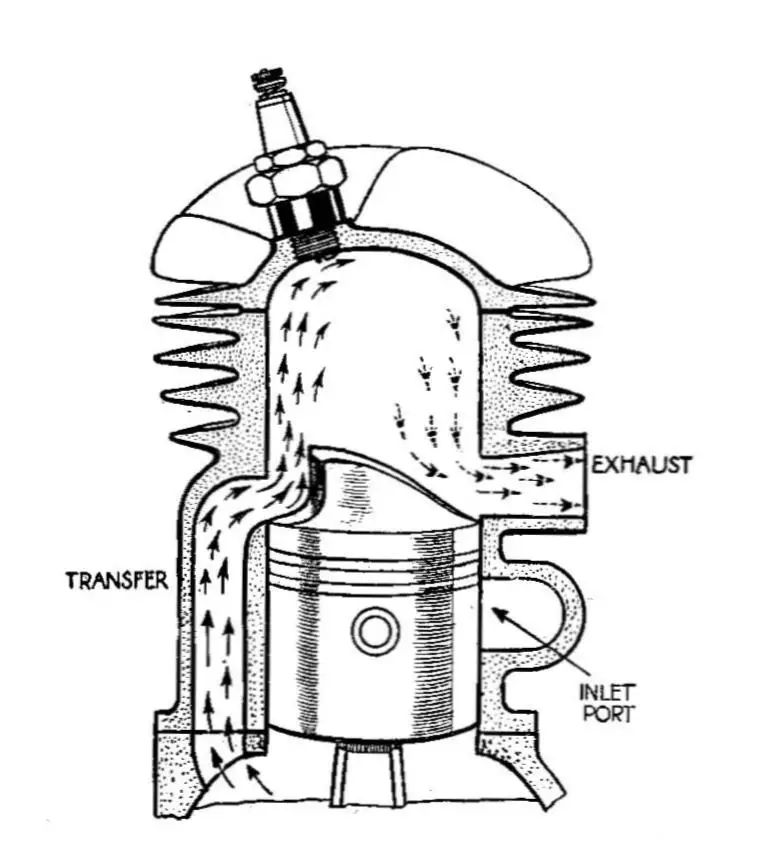
You’ll also notice in the 2-stroke engine the piston head is not flat, it has a shape to it. It is there to change the path of the incoming air-fuel mix that comes in from the transfer ports so that it cannot escape easily.
Summary
Even though 4-stroke engines aren’t perfect, they are much more fuel-efficient than a 2-stroke engine. Some unburned fuel will always be wasted, but it is wasted much less in 4-stroke engines.
2-stroke engines on the other hand are much lighter because they don’t have camshafts or valves, or valve springs, etc. They will also produce power every 2 strokes instead of 4, which means that for the same amount of rpm, the 2-stroke will have more combustions. They are popular in go-kart racings, dirt bikes, etc.
